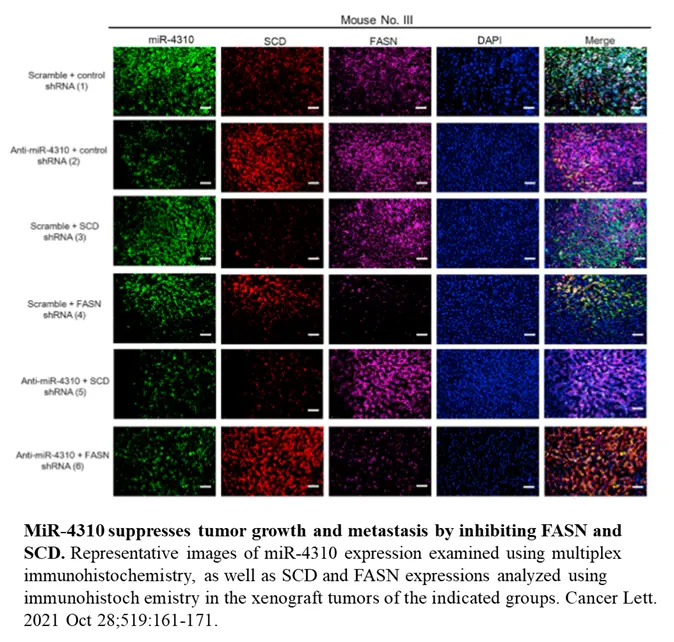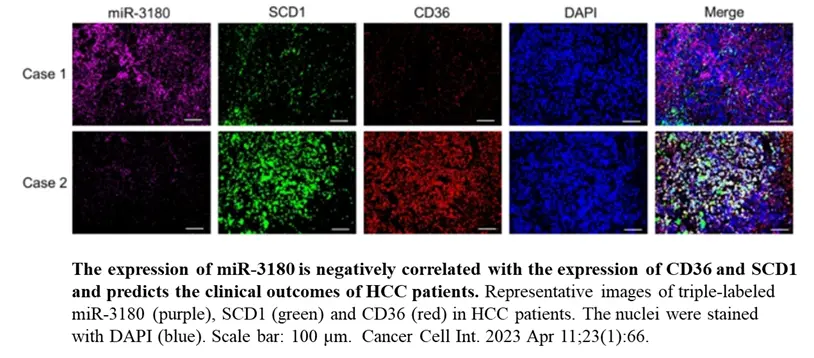Cy3 TSA Fluorescence System Kit
- 1. Ling Li, Xiujuan Zhang, et al. "Transcriptional Regulation of De Novo Lipogenesis by SIX1 in Liver Cancer Cells." Adv Sci (Weinh). 2024 Nov;11(41):e2404229 PMID: 39258807
- 2. Xinrui Dong, Huijuan Dai, et al. "TIMELESS upregulates PD-L1 expression and exerts an immunosuppressive role in breast cancer." J Transl Med. 2023 Jun 20;21(1):400. PMID: 37340461
- 3. Jie Hong, Jie Liu, et al. "MiR-3180 inhibits hepatocellular carcinoma growth and metastasis by targeting lipid synthesis and uptake." Cancer Cell Int. 2023 Apr 11;23(1):66. PMID: 37041584
- 4. Huayue Li, Zhongwu Chen, et al. "MiR-4310 regulates hepatocellular carcinoma growth and metastasis through lipid synthesis." Cancer Lett. 2021 Oct 28;519:161-171. PMID: 34303763


Related Biological Data

Related Biological Data



| Complete Kit | 100-300 slides | 200-600 slides |
| 1X Amplification Diluent | 30 mL | 60 mL |
| Cyanine 3 Tyramide (dry, dissolve in 60 μL DMSO) | 1 tube | 2 tubes |
| Blocking Reagent | 6 g | 12 g |
Store Cyanine 3 Tyramide in the dark at -20°C for 2 years. Keep 1X Amplification Diluent and Blocking Reagent at 4°C for 2 years. | ||
Tyramide Signal Amplification (TSA) from APExBIO increases sensitivity by a factor of 100 and enables detection of low-abundance targets in fluorescent immunocytochemistry (ICC), immunohistochemistry (IHC) and in situ hybridization (FISH) applications.
The TSA Fluorescence Kit uses horseradish peroxidase (HRP) to directly catalyze the covalent deposition of the fluorophore adjacent to the immobilized enzyme. The labeling process is so fast (less than ten minutes) and the deposition label can be viewed directly under standard or confocal microscopy. TSA fluorescein can also be used in combination with anti-fluorescein.
TSA technology is used for bright field microscopy of enzyme conjugates and suitable chromogenic substrates. The use of TSA reagents results in a significant increase in sensitivity compared to standard assays while maintaining stable specificity and resolution. In addition, TSA reagents can significantly reduce the consumption of primary antibodies or probes. The fluorescent labeling signal of this kit (K1051) is Cyanine 3, which can be detected the signal by microscopy at the excitation and emission wavelengths (550 nm/570 nm).

Schematic diagram of tyramide signal amplification system
Label the cell or tissue sample with the primary and secondary antibodies using conventional methods. The horseradish peroxidase (HRP) conjugated to the second antibody catalyzes the conversion of the labeled tyramide to a reactive radical, and the tyramide radical is covalently bound to a nearby tyrosine residue to provide a high-density label.











